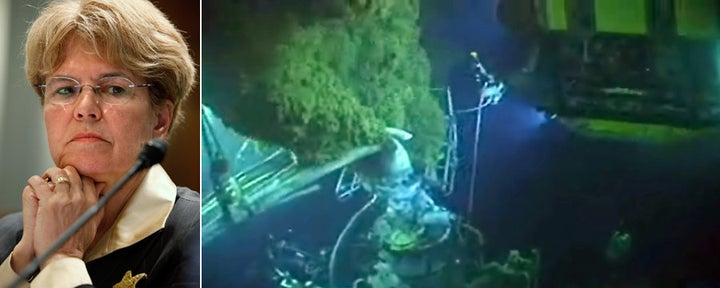
Despite more than three weeks of accumulating scientific evidence that gargantuan plumes of oil lurk beneath the surface of the Gulf of Mexico -- presenting an imminent threat to sea life and a possibly decades-long threat to the nation's coastlines -- NOAA Director Jane Lubchenco on Wednesday refused to contradict BP CEO Tony Hayward's statement over the weekend that "the oil is on the surface" and "there aren't any plumes."
Scientists on NOAA and academic research vessels have been reporting since the week of May 10 that they have spotted -- and sampled -- oil suspended in the water column. And the Huffington Post has learned that lab results from a previously secret NOAA research mission have been analyzed; its results just haven't been made public.
But to Lubchenco, the Obama appointee running the National Oceanic and Atmospheric Administration, all the accumulated evidence is just "circumstantial."
And what others call oil, she calls "anomalies."
"I can tell you that there have been a number of anomalies identified by a number of different cruises," she told reporters in a conference call. "Those anomalies are features at various different depths in the water column that may be oil, they may be other features."
"It is quite possible that there is oil beneath the surface," Lubchenco finally acknowledged under repeated questioning. "I think there is reason to believe that may be the case." But that's as far as she would go.
"I am not at all in denial," she insisted.
Lubchenco was speaking from the deck of the NOAA research vessel Thomas Jefferson, which, 43 days into BP's oil-spill disaster, is off on a 10-day effort to take water samples and advanced measurements beneath the surface.
Lubchenco wouldn't say when the results from the Jefferson would be made public. "Their plan is to drop off samples partway through the mission," with lab results being available "in the not too distant future after that."
Lubchenco said that until samples are taken "according to rigorous protocols and then processed in the lab" they cannot be considered definitive. "There have been a number of things that look suspicious, but we have yet to see confirmed lab results that give us definitive information," she said.
But HuffPost has learned that a NOAA-commissioned research cruise the week of May 10 took extensive samples up and down the water column near the Deepwater Horizon spill site -- and that those samples have in fact been processed, and logged in with the incident command.
Deborah French McCay is the director of Applied Science Associates, an environmental consulting company based in Rhode Island that is working as part of NOAA's Natural Resources Damage Assessment. She told HuffPost she organized a mission on the private research vessel Jack Fitz more than three weeks ago.
"They went out and sampled all the way up and down the water column," she said. That included tests for chemistry, oil concentration, temperature, salinity, oil droplet size and so on. Preliminary descriptions clearly indicated the presence of oil beneath the surface -- and the final lab results, she said, came in Monday night.
There is also, she said, video from a remotely operated underwater vehicle from the Jack Fitz showing oil beneath the surface. "You could see it in the water column," she said.
But she doesn't have the video, she said. "NOAA does."
And Nicole Mulanaphy, a chemical engineers for McCay's firm, told HuffPost on Wednesday that she could not release any data without NOAA's say-so. "One of their lawyers would have to provide their permission," she said.
The Jack Fitz mission has been previously unreported in the media -- or by NOAA. But, despite a slow start, several scientific missions have by now very publicly detected the presence of oil beneath the surface. Those include:
* The Pelican, whose May 10-16 mission was extensively blogged on the Nature magazine website. NOAA-sponsored scientists discovered and tracked the plume that doesn't officially exist -- and were blasted by Lubchenco for talking to the media when they got back.
* University of South Florida researchers on the WeatherBird II last week found a six-mile-wide, 22-mile-long plume "broken into millions of bits and beads and moving with the current," stretching from just beneath the surface to depths of 3,300 feet.
* Over at the Gulf Oil Blog, University of Georgia professor Samantha Joye has been blogging from the research vessel Walton Smith. On Sunday, she blogged about how, after finding indicators of subsurface oil, she and her fellow researchers could now actually see it. See? And on Monday, she wrote that the ship had "closed in on the source of the plume. After a very long day, we finally have this feature well constrained. We found more visible oil in the deepwater today -- at different sites from yesterday -- which increases our confidence in this finding."
In fact, ABC News has a video report from the Walton Smith:
Meanwhile, one independent scientist is telling the Rachel Maddow Show that in return for being allowed aboard a NOAA boat, he's being forced to submit to a gag order.
"I'm essentially being told that the data I'm collecting on my hypoxia cruise may or may not be subject to quarantine," Steven DiMarco, a professor in the oceanography department at Texas A&M, told Maddow. "Which means that we will not be able to publish it, pending the liability litigation. Oh, yeah, 20 years from now, we may be able to publish it."
Other scientists see NOAA's reluctance to state the obvious and insistence on keeping data secret as serving only one purpose: BP's.
BP, after all, repeatedly misled the government and the public about the volume of the spill. Denying that there is any oil beyond what is visible on the surface continues that deception.
Jeff Short, a former NOAA official who now works for the ocean advocacy group Oceana, said Hayward's comments dismissing reports of sub-surface oil came "right out of the playbook for Exxon and the Exxon Valdez saga -- which is to say all the right things in public and act deplorably in private."
Short said Exxon's goal was to do everything it could -- including dispute government finding with its own specious research -- to minimize its legal liability.
Short also said that despite their reticence in public, NOAA officials presented conclusive data regarding sub-surface oil at a closed-door meeting with scientists in Baton Rouge last week. "The data that NOAA presented at that meeting was irrefutable," he said.
Short said he could only speculate about NOAA's motives for going along with BP's specious claims, rather than publicly disputing them. "I think they're being extremely cautious. Perhaps they have some legal strategy that precludes them from commenting in public. But they are not doing the public a service in being so secretive," he said.
"It's their job to tell us the basics of what's going on."
Lest there be any doubt that it is official NOAA policy to minimize the nature of the threat posed by sub-surface oil, NOAA spokesperson Rachel Wilhelm on Thursday e-mailed the following statement to the Huffington Post:
In oil spills, we expect to see dispersed and dissolved hydrocarbons and oil in the water column, and particularly so in this incident because BP is using subsurface dispersants. Within a few kilometers of the well, there is clearly a dense plume of oil droplets in the water column. While no cohesive subsurface plumes of oil have been found beyond the immediate area of the leaking well, samples collected by the Weatherbird and the Pelican last week indicated subsurface anomalies. The water samples collected during the missions are being analyzed.
Until the data is analyzed it is premature to draw conclusions. There is ongoing sampling by multiple ships and crews to determine just how much subsurface oil there is. [Bold in the original.]
Told of Lubchenco's comments -- and asked about the still-secret Jack Fitz data -- marine specialist and Greenpeace advisor Rick Steiner told HuffPost: "The fact that they've got this information and they're still not releasing it, that's irresponsible. The public deserves to know this stuff.
"Particularly if they're going to do rational beach closures and fishing closures, they are going to have to know where these sub-surface plumes are moving... Excuse me, anomalies. Did I say plumes?
"It's infuriating. Here we are in the biggest environmental catastrophe of our time, and the limited amount of science that's being done is being concealed from the public? I mean, c'mon. This is the United States of America."
UPDATE: Listen to the conference call. (My question was the very last one.)
*************************
Dan Froomkin is senior Washington correspondent for the Huffington Post. You can send him an e-mail, bookmark his page; subscribe to RSS feed, follow him on Twitter, friend him on Facebook, and/or become a fan and get e-mail alerts when he writes.
